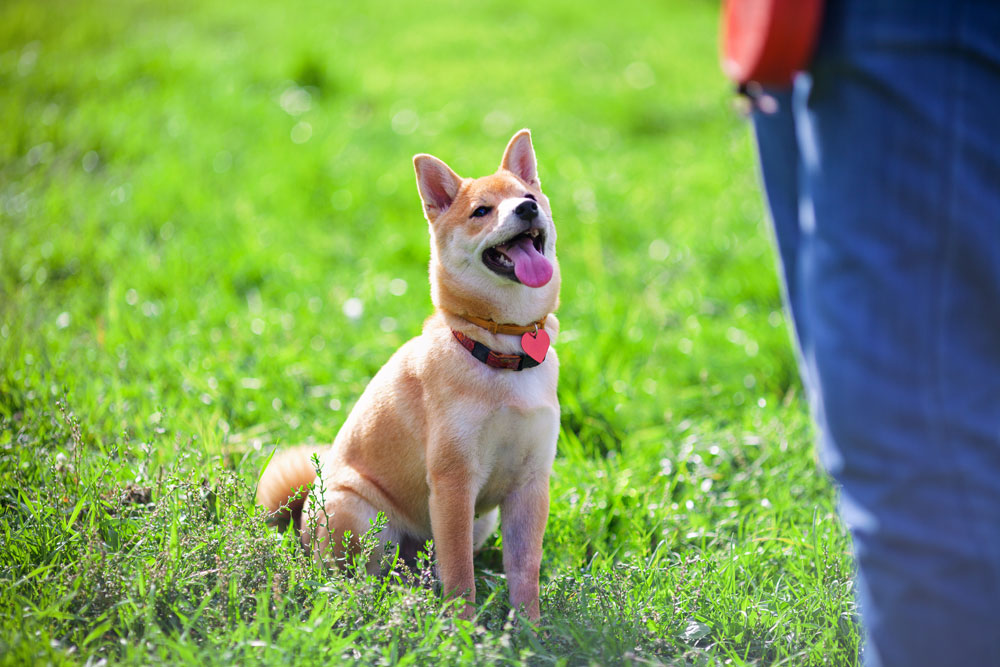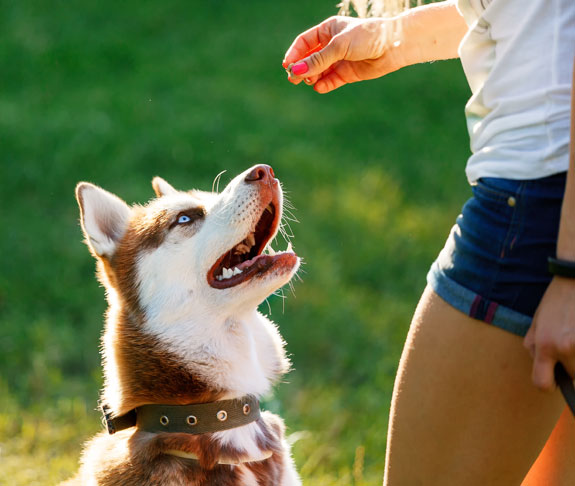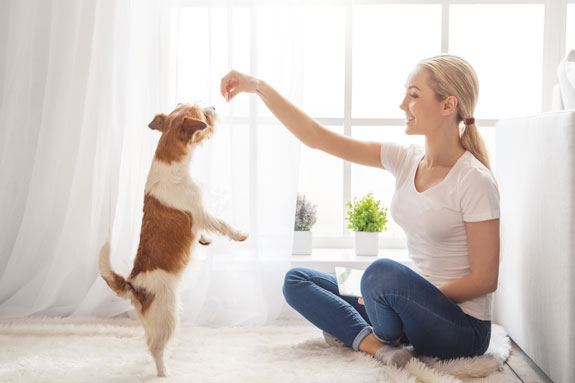10 Basic Commands To Teach Your Dog

IMPORTANCE OF DOG TRAINING
Dog training builds a language between you and your dog. This language encourages feelings of comfort and security, which can help in the prevention of inappropriate behavior, like growling or snipping at strangers. Additionally, it can help to prevent your dog from developing behavioral problems, like jumping on others or barking excessively. The most common causes of behavioral problems are incorrect punishments or a lack of consistency in training. Therefore, you need to be sure you're 100% ready to take the time to train your dog and be consistent.
For first-time dog owners and veteran dog parents alike, understanding how and when to train your canine companion can be confusing! Whether you have a brand-new puppy or you've adopted an adult hound, we've consulted the training experts to provide you with some help.
So, whenever you, your dog, and your treats are ready, check out these 10 basic commands to teach your dog, and how to go about them.
WHAT DO I NEED TO HAVE FOR MY DOG TO TRAIN WITH ME? TREATS, TOYS, OR OTHER INCENTIVES?
As with any other training method, the reward system has always proven useful. It adds a sense of accomplishment, establishes trust between you and your pet, and is surely enticing.
"First and foremost, you need to have your dog's attention! What you should use to get their attention varies with each dog. Some are more motivated by food than others. Some will do anything for their favorite toy, and still others just want attention and affection from their favorite person. In any case, you will also want to have your dog on a leash so that you can control and guide them if and when it's needed.", says Antonio Diaz.
When considering what you would like to train your dog to do and what you will use to accomplish this, it also helps to think about where you're training!
"It's good to start training in a quiet, distraction-free room in the house. If you're going to be using clicker training as a method, you'd want a clicker handy, and ideally, a pouch that fastens around your waist or clips to your belt loop to hold treats and/or toys close at hand. Have in mind the verbal cue word and hand signal you're going to use, to teach a particular skill.", adds Susan Frank.
Another important factor is patience! Remember that training does take time, and not all dogs learn at the same pace.
"First of all, you need time and patience. Training is a process that takes repetition and perseverance. Treats, toys, vocal (like a good boy!), and physical (petting) rewards are all good incentives. Use whichever ones motivate your dog.", says Renee Dobbs.
SHOULD I HAVE MY DOG MASTER ONE COMMAND BEFORE MOVING ON TO TEACHING THEM A NEW ONE?
Training is now always an easy feat. It helps to add in commands as you go, progressively introducing them to several at a time, then revisiting them.
"While many people believe you can only train one command at a time, I like to work on multiple at once. It adds variety, keeps training sessions interesting for you and your dog, and can speed up the training process.", says Melissa Gundersen.
Some suggest that to teach your dog a new command, they should have learned or mastered a more basic version first!
"If you wanted to teach your dog to shake a paw, you have to teach sit first! I often start with site, spin in circles, and lay down as my first three commands for puppies. 10 successful attempts at a trick means the dog has learned the trick, and 100 successful attempts mean the trick is "mastered.", shares Kaitlin Primrose
In other circumstances, it will depend on your dog. How quickly do they pick things up, how much do they enjoy training and their personality?
"No dog will ever "master" any behavior completely. With that being said, I would recommend focusing on a specific behavior for each training session, but being flexible in what needs to be trained for that specific day." , adds Devin Stagg.
IS THERE A CERTAIN ORDER I CAN TEACH COMMANDS TO MY DOG FOR THEM TO HAVE THE BEST CHANCE OF UNDERSTANDING THEM? SIT, LAY DOWN, SHAKE, RETRIEVE?

Depending on how quickly your dog picks new things up, chances are there are a few different approaches that will work.
"When I am training a new puppy, I generally start with the most important life skills first. Skills like "come", "sit", and "touch" is, in my view, three of the foundational skills a dog should know.", says Stephanie Seger.
By starting with the basics, your dog will gain confidence in their ability to accomplish what you are asking for and will progress in overall obedience. Also, keep in mind which commands will be useful rather than just "cute".
"While the order in which you teach commands to be understood best by your dog is irrelevant, there is an order to teach practical commands. Typically the first command you should teach your dog is the recall (come when called). This is largely due to safety. You want to make sure that if ever your dog is moving away from you, towards a potentially life-threatening situation, you can call them back to you. If I had to put commands for practicality, I'd list them like this: Come, Heel, Sit, Place, Down, Leave it, Drop it.", says Antonio Diaz.
Familiarizing them with their name, your tone of voice, general training practices, and safety-related commands is always a great place to start.
"Making sure the dog knows its name is helpful to get their attention in the first place. Then teaching the ability for the dog to settle down and "sit" in front of you, leads naturally, to teaching them to "stay" is a good way to learn impulse control. This segways nicely into a "down" (as in laying down). For safety, teaching "come" is probably one of the first and most important commands for them to learn." says Susan Frank.
WHEN SHOULD I START TRAINING MY DOG? AS A PUPPY? AT 6 MONTHS? IMMEDIATELY AFTER ADOPTING AN ADULT?
If you are new to dog ownership, understanding when to get started can be confusing!
"Training should start as soon as you get your new puppy. Basic commands such as sit and stay can be taught to puppies at 8 weeks. More advanced commands can be taught to puppies once they are 6 months old. For adult dogs, allow some time for the dog to adjust to its new home, which could be a few days or months depending on the dog.", mentions Renee Dobbs.
Now once again, depending on the dog's feelings toward you and the home, you can start training right away! This will help them feel a sense of belonging and establish you as their owner.
"Immediately! No matter how old your dog is when you welcome them into your home (and, yes, old dogs can learn new tricks), training should start on Day 1!", adds Melissa Gundersen.
Once you have brought your new pet home, there are a few actions that can help establish trust and a bond that will later boost your ability to train.
"As soon as you get home with your new dog you may begin training! I don't feed my dogs out of bowls for at least the first week. I use kibble in a treat bag and feed them throughout the day for basic things like going potty outside, coming, checking in with me, and looking into my eyes.", says Kaitlin Primrose.
WHAT ARE 10 BASIC COMMANDS THAT I CAN TEACH MY DOG THAT THEY ARE MOST LIKELY TO FIND SUCCESS WITH?
Day 1 with your new companion may not be the best time to teach complex tricks, so when is a good time? And what should you start with?
"Leave it, look at me, sit, stay, down, come when called, shake, speak, stand (on all 4 paws, very useful for grooming), place, or settle.", shares Devin Stagg.
Whether you choose to follow a particular order or not, if you are just getting started training, these commands are a great place to begin and will help the most!
"Rather than using a goal of 10 easy commands to teach, I recommend this list of 10 skills that most impact you and your canine partner's life together. Those skills will make living together harmonious and enjoyable. The top 10 commands, as indicated by Stephanie Seger, are:
- Come
- Stay
- Touch
- Loose Leash Walking
- Leave It
- Place or On Your Bed
- Back
- Sit
- Down
- Shake, says Stephanie Seger.
And just like with anything else that requires learning, consistency is the key! Train with your dog frequently to achieve the best results.
"At a basic level, I'd say these are the 10 commands. Come, Sit, Down, Place, Stay, Heel, Kennel, Leave it, Drop it, Watch me. Success with any of these commands lies in the approach. Your dog will most likely be successful with these commands if you practice frequently, make it rewarding to do them, make sure they do them when told, and by effectively control the environment in which you practice (from least distracting to most distracting).", shares Antonio Diaz.
Some of the other important commands to consider include heel, look, quiet, and handling their business. All of these commands are explained below:
Stay: If you're thinking of ditching the leash anytime soon, you have to train your dog to stay. It's a control command that keeps it unruly and manages behavior when necessary.
Come: This is a useful command for directing your dog towards yourself. It is especially important to perfect your dog's training in this regard if you're planning on taking your dog off its leash.
Touch: This is a command that helps establish control over your dog. Just like the stay command, touch could be used to put an anxious dog at ease.
Loose Leash Walking: Loose leash walking is necessary to ensure safety while on walks. The training also makes it easy for owners to relax better when walking with pets. You'd appreciate the command if your pooch is a restless one.
Leave It: In human relations, it's important to say no to set boundaries. This command is intended to do the same thing for your pooch. With such a command, your dog should understand when an article or activity is off-limits to them.
Place or On Your Bed: You can't reasonably allow your dog to roam around all day long jumping all over your bed or furniture. To avoid this, you create a designated area, space, or bed for them. All that's left is training them to understand when you want them in their designated space. This command does that for you.
Bark: This is another play command that could be a source of fun between you and your dog. There's no functionality to the act, except being able to make your dog bark on command, but it could boost the connection between the two of you.
Sit: Many dog trainers consider this the most teachable command because the dog is essentially performing a more natural act. As such, this is a transition command to boost a dog's cooperativeness before moving on to other, more difficult commands.
Down: This is a very relaxing command that a dog can get used to quite easily. The best treats or incentives to employ in this training are extended play periods or food treats immediately afterward.
Shake: This is another play trick that could be a source of fun between you and your dog. Teaching your dog to shake on command can help strengthen you and your dog's bond.
Heel: When taking your dog on a walk, you want to exhibit a certain level of control over their pace and their closeness to you. This command helps in practicing a more controlled walk.
Look: A command to call your dog's attention; this should ensure that your dog is trained to seek your presence.
Quiet: Use this command to stop your dog from barking on command. A very necessary command to avoid disturbing the neighbors and passers-by.
Handle Your Business: Having a mess to clean now and then isn't an ideal choice for anyone. Training your dog to use the restroom in a more appropriate place helps prevent those messes in public.
SHOULD I REWARD MY DOG EACH TIME THEY FOLLOW A COMMAND? For example, a treat every time they sit, or shake, or should I hold back to encourage them to follow commands without incentives?

If they have been doing the same command for years, should they get a treat for doing it? Only when it is a new trick? Ultimately, it is up to you, but certain methods may work better than others.
"In positive reinforcement training, the schedule of reinforcement is an important aspect. It has to do with the frequency of how often you will reward. Simply put, at the beginning, when teaching your dog a new skill, you'll be rewarded quickly and every single time she performs the behavior. Once the dog can do it consistently, you'll be changing this and rewarding less often – most of the time, then, down to half of the time until you only need to reward occasionally.", adds Sharon Frank.
As they begin to master a command, over time, you'll reduce the number of rewards they get for the same thing.
" You should reward your dog each time they follow a command until the command is mastered. For instance, once your dog has mastered come, you will no longer need to reward the dog every time the dog comes when called.", shares Renee Dobbs.
Treats have proven to be effective for your pet! Just be sure not to reward your pooch for every little thing.
"Once your pup seems to have a solid understanding of each command, you can start phasing out the treat or toy. Of course, you should continue to verbally praise your pup when they listen. While training begins the day you welcome your pup into your home, it never ends.", says Melissa Gundersen.
HOW SHOULD I SPEAK TO MY DOG WHEN I AM TRAINING? SHOULD I SPEAK WITH AN AUTHORITATIVE TONE OR A GENTLE ONE?
Dogs have a love language, too! It is important to know how to address them when training.
"Fun, excited, and happy. You should have a tone that makes your dog's tail wag. Remember that training should be fun!", adds Kaitlin Primrose.
Just like with people, it is crucial to have an awareness of how your tone affects your dog.
"I always ask people, how would you like to be spoken to? Generally, we want to speak clearly and simply to our dog, without yelling or being too forceful." , shares Devin Stagg.
It sounds happy and excited, but not without reason – it should not come out like gibberish. Remember, they're watching you for understanding, so use your body to direct them!
" I recommend enthusiastic clarity when it comes to speaking to my dogs. I do not recommend a lot of talking, as most of our yapping is nothing more than "blah, blah, blah" to our dogs. However, a happy, easy-to-understand tone, saying commands ONCE, and using body language to encourage, are the best ways to communicate with your dog during training. Keep in mind, dogs are paying more attention to your body than they are your mouth, so be very mindful of what you are doing with your body while training.", says Stephanie Seger.
WHAT IS THE BEST WAY TO TRAIN A DOG TO ANSWER COMMANDS?
There are no sure-fire ways to train your pet. Those are the sentiments we have tried hard to share. Rather than sharing a "sure" approach to having a well-trained pooch, we can only give general guidelines to help your dog's training efforts. This most important advice is to alternate the adherence to a command with the offer of a treat.
When training your dog, have a treat on hand to reward them every time they answer the command correctly. That's just the trick to it. Design exercises that help your dog identify obedience with rewards and you are good to go.
WHAT ARE SOME NON-TANGIBLE THINGS I CAN DO TO ENCOURAGE MY DOG TO FOLLOW COMMANDS?
There are a few considerations you can make when deciding on this factor. Experts recommend trying several things to understand what works best.
"1. Start in a distraction-free environment. Typically this would be inside your home or garage. Then, gradually train in slightly more distracting environments.
2. Make training fun for your dog and treat it like a game that is easy for them to win and be successful at. A positive attitude can go a very long way.
3. Use your commands frequently, in situations when you don't need to use them. This helps create muscle memory and keeps the behavior alive in their mind. The saying "if you don't use it, you lose it" definitely applies here.", adds Antonio Diaz.
Another expert talks us through what they call "life rewards".
"Life rewards are anything that your dog loves, such as being allowed to leave the path to sniff the base of a tree, or playing fetch with a stick you pick up off the ground, or the simple act of opening to door to go outside. You can reward your dog with these during everyday activities, and as it happens that at any time, something great can happen, through these rewards, your dog is encouraged to pay attention and listen.", shares Susan Frank.
Lastly, the help of dog training can always be considered! If you have a particularly stubborn pooch or you could simply use some help, they are there for a reason.
"Praise, petting, and play are rewards you can give your dog to reinforce good behavior and following commands. On another note, in some cases, it may be necessary to get help from a professional trainer. Fearful dogs, reactive dogs, and dogs that were not socialized properly as a puppy are a challenge to train. Professional trainers can teach you techniques to use that are specific to your dog's behavior." says Renee Dobbs.

And there you have it! For first-time owners, referring to the experts is always a good place to start. We hope that you and your canine companion find luck in training, and don't forget to have fun while you're at it!
Previous article

Next article

Related posts
View all-

National K9 Veterans Day: Why and How to Celebrate
National K9 Veterans Day is celebrated every year on March 13th. This year its on Saturday March 13th, 2024. This day was established to recognize and celebrate the contributions that Military Working Dogs.
Read Article -

Puppy Training Tips
Training your pup from day one helps set a solid foundation for good behavior and a well-adjusted adult dog. Puppies thrive on structure, and a predictable routine makes learning easier.
Read Article -

Spring Cleaning Tips for Pet Parents
Say goodbye to the winter germs and hello to all the new spring smells! The beginning of spring is the perfect time to clean your house. For pet owners, this can mean more in-depth cleaning in areas other people don't have to worry about. We will give you some helpful tips and tricks so that cleaning up after your pet seems a little less daunting. Read Article



